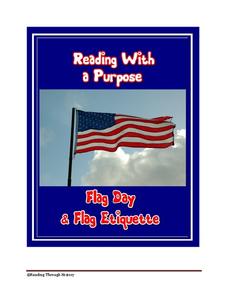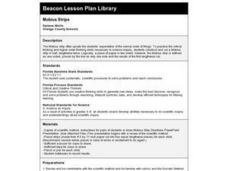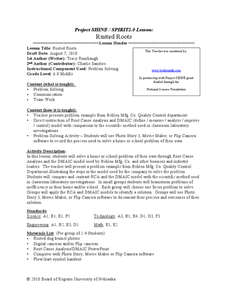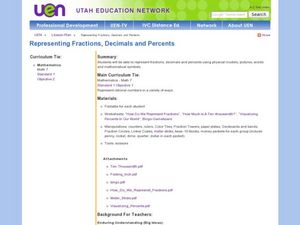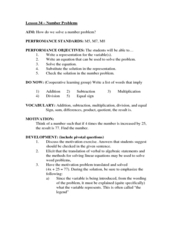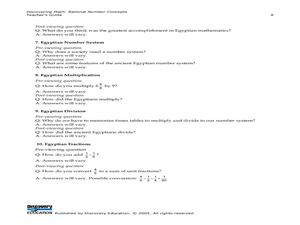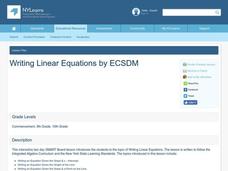Curated OER
Creating a Personal Symbol
Students inquire about visual arts by creating an artistic etching. In this symbolism lesson plan, students identify the work of Keith Haring by researching the web and analyzing images. Students utilize linoleum or wood to create an...
Curated OER
Scientific Method "Lab Writeup"
Pupils analyze and experience the scientific method. They discuss the various steps of the method, conduct various experiments, and write a three-paragraph essay regarding their conclusion.
Reading Through History
Flag Day
Why is the United States flag such an important symbol to America that it gets its own day to celebrate it? Pupils read a passage that discusses the symbolism and significance of the American flag. Following the reading, they answer quiz...
Curated OER
Mobius Strips
Students discuss the scientific method and construct their own Mobius Strips. They examine their Mobius Strip, and write observations and a hypothesis on how many strips of paper they have when they cut the strip in half length-wise.
Curated OER
The Science of Color
Students use the scientific method to explore how to make different colors with paint. They problem solve ways to darken and lighten colors without using black and white paint. Students hypothesize how to create new colors, and describe...
101 Questions
Foreign Subway Order
Subway orders are the same in every language, right? An inquiry-based lesson presents a Subway ordering board from an Asian country. Given an order, learners must determine the cost by comparing symbols of the order to the symbols on the...
Curated OER
Rusted Roots
Students create a flowchart on the root cause method. In this inquiry lesson, students compare RCA and the DMAIC model with the scientific method of problem solving. They investigate a problem in school and present their findings in class.
Curated OER
Method of Solution
High schoolers explore the Method of Solution. They identify the components of the Method of Solution. Students develop the method of solution for a project that includes how the computer will be used, the mathematical equations needed...
Curated OER
Balancing Equations
Students practice balancing chemical equations using the trial and error method. In this balancing equations lesson plan, students use paper squares labeled with specific atoms to balance 5 given chemical equations.
National Geographic
Genetic Markers: Connecting the Dots
Biology buffs simulate how genetic markers are passed among populations in order to understand how these markers can help anthropologists map human migration. A couple of volunteers leave the room while you walk the remaining learners...
Curated OER
Representing Fractions, Decimals, and Percents
In this fractions, decimals, and percents lessons, students explore various methods of representing fractions. They demonstrate situations that represent rational numbers. Students create a foldable exploring fractions, decimals and...
Curated OER
Roman Bernardo: Solving Linear Equations
Mathematicians use an inquiry method to solve linear equations. In this linear equations instructional activity, students practice solving equations using addition, subtraction, multiplication and division. They solve multi-step...
Curated OER
Number Problems
Students write equations for problems. In this number lesson, students add, subtract, multiply and divide numbers to solve for a variable. They rewrite word problems using algebraic symbols.
Curated OER
Cardboard Radial Weaving
Students explore cultural history by participating in an arts and crafts activity. In this weaving lesson, students identify the many cultures that used weaving methods and local plant life to create baskets and other useful tools....
Curated OER
Pollution in the Air and the Water Pollution Solution
Students explore air pollution. In this ecology and air pollution lesson, students perform an experiment in which a Vaseline coated lid is placed inside and outside the classroom. Students make predictions and then record what they see...
Curated OER
Communication in Bees
Eighth graders identify and interpret a scientific investigation and a hypothesis through experimentation and testing a hypothesis. They identify what scientists hypothesized about the communication of stingless bees. Finally, 8th...
EngageNY
Numbers in Exponential Form Raised to a Power
Develop an understanding of the properties of exponents through this series of activities. This third lesson of 15 explores the patterns associated with the power property. Scholars expand the powers before applying the property.
Curated OER
What's The Point?
Students solve word problems using the correct math symbols. For this algebra lesson, students use the TI calculator to graph their equation and analyze it. They find the line of regression and use to draw conclusion.
Curated OER
Infinite Secrets
Young scholars duplicate the method that Archimedes used to estimate the value of pi. They complete a data table and find the approximate values of pi for three sets of polygons.
Curated OER
Discovering Math: Rational Number Concepts
Students explore the concept of Egyptian contributions in mathematics. In this Egyptian contribution lesson, students research Egyptian hieroglyphics and pyramids. Students write numerals in hieroglyphics. Students use Egyptian methods...
Curated OER
Writing Linear Equations
Students rewrite word problems using algebraic symbols. In this algebra lesson, students write linear equations using the slope and y intercept. They write equations given two points that are on the line.
Curated OER
The Mystery of Christa’s Big Bubble
Students study effervescence. In this hands-on science lesson, students apply the scientific method as they complete an activity regarding the presence of bubbles in liquids.
Curated OER
Making Connections
Seventh graders relate patterns with higher math. In this 7th grade math lesson, 7th graders analyze different methods of portraying data. They relate the data to real life scenarios.
Curated OER
Word Problems
Students solve word problems using mathematical symbols. In this algebra lesson, students collect data and analyze it. They analyze the data using a table or graph after plotting the data.


